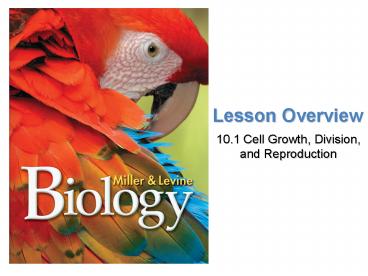Lesson Overview - PowerPoint PPT Presentation
1 / 12
Title:
Lesson Overview
Description:
Lesson Overview 10.1 Cell Growth, Division, and Reproduction Information Overload Living cells store critical information in DNA. As a cell grows, that ... – PowerPoint PPT presentation
Number of Views:33
Avg rating:3.0/5.0
Title: Lesson Overview
1
Lesson Overview
- 10.1 Cell Growth, Division, and Reproduction
2
Information Overload
- Living cells store critical information in DNA.
- As a cell grows, that information is used to
build the molecules needed for cell growth. - As size increases, the demands on that
information grow as well. If a cell were to grow
without limit, an information crisis would
occur.
3
Information Overload
- Compare a cell to a growing town. The town
library has a limited number of books. As the
town grows, these limited number of books are in
greater demand, which limits access. - A growing cell makes greater demands on its
genetic library. If the cell gets too big, the
DNA would not be able to serve the needs of the
growing cell.
4
Exchanging Materials
- Food, oxygen, and water enter a cell through the
cell membrane. Waste products leave in the same
way. - The rate at which this exchange takes place
depends on the surface area of a cell. - The rate at which food and oxygen are used up
and waste products are produced depends on the
cells volume. - The ratio of surface area to volume is key to
understanding why cells must divide as they grow.
5
Ratio of Surface Area to Volume
- Imagine a cell shaped like a cube. As the length
of the sides of a cube increases, its volume
increases faster than its surface area,
decreasing the ratio of surface area to volume. - If a cell gets too large, the surface area of
the cell is not large enough to get enough oxygen
and nutrients in and waste out.
6
Traffic Problems
- To use the town analogy again, as the town
grows, more and more traffic clogs the main
street. It becomes difficult to get information
across town and goods in and out. - Similarly, a cell that continues to grow would
experience traffic problems. If the cell got
too large, it would be more difficult to get
oxygen and nutrients in and waste out.
7
Division of the Cell
- Before a cell grows too large, it divides into
two new daughter cells in a process called cell
division. - Before cell division, the cell copies all of its
DNA. - It then divides into two daughter cells. Each
daughter cell receives a complete set of DNA. - Cell division reduces cell volume. It also
results in an increased ratio of surface area to
volume, for each daughter cell.
8
Asexual Reproduction
- In multicellular organisms, cell division leads
to growth. It also enables an organism to repair
and maintain its body. - In single-celled organisms, cell division is a
form of reproduction.
9
Asexual Reproduction
- Asexual reproduction is reproduction that
involves a single parent producing an offspring.
The offspring produced are, in most cases,
genetically identical to the single cell that
produced them. - Asexual reproduction is a simple, efficient, and
effective way for an organism to produce a large
number of offspring. - Both prokaryotic and eukaryotic single-celled
organisms and many multicellular organisms can
reproduce asexually.
10
Examples of Asexual Reproduction
- Bacteria reproduce by binary fission.
- Starfish can reproduce by fragmentation.
- Hydras reproduce by budding.
11
Sexual Reproduction
- In sexual reproduction, offspring are produced
by the fusion of two sex cells one from each of
two parents. These fuse into a single cell
before the offspring can grow. - The offspring produced inherit some genetic
information from both parents. - Most animals and plants, and many single-celled
organisms, reproduce sexually.
12
Comparing Sexual and Asexual Reproduction































